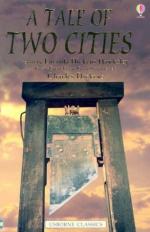|
This section contains 9,162 words (approx. 31 pages at 300 words per page) |

|
SOURCE: “Alternatives to Bourgeois Individualism in A Tale of Two Cities,” in Studies in English Literature 1500-1900, Vol. 30, No. 4, Autumn, 1990, pp. 633-54.
In the following essay, Baldridge explores an aspect of the French Revolution depicted in A Tale of Two Cities that he claims has been neglected by critics: the assertion that “the group, the class, the Republic—and not the individual—comprise, or should comprise, the basic unit of society.”
Dickens's ambivalence toward the Revolution he depicts in A Tale of Two Cities has been the subject of much thoughtful comment, and over the past few decades a number of differing causes for this ambivalence have been proposed. George Woodcock, for instance, sees in the “vigor” with which the author depicts the scenes of Revolutionary violence a kind of vicarious retribution against the society which betrayed him in his youth: “in one self [Dickens] is there, dancing...
|
This section contains 9,162 words (approx. 31 pages at 300 words per page) |

|


